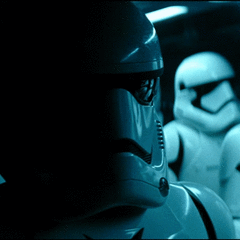-
Posts
3,849 -
Joined
-
Last visited
Reputation Activity
-
 Jarsky got a reaction from Needfuldoer in Moving 200TB of Data quickly?
Jarsky got a reaction from Needfuldoer in Moving 200TB of Data quickly?
I would take the approach of "if it aint broke, dont fix it", unless the company are adamant that they want a single volume.
If its a mixture of "Working Data" and "Archive Data", then I would do a data shuffle to redesign the volumes to be working projects and archived projects if that makes more sense to them to be easier to find what theyre looking for.
-
 Jarsky got a reaction from vogam7 in Synology NAS RAID 10 question
Jarsky got a reaction from vogam7 in Synology NAS RAID 10 question
sorry I mixed that up, thats the correct order I meant. So yeah stagger them.
-
 Jarsky got a reaction from vogam7 in Synology NAS RAID 10 question
Jarsky got a reaction from vogam7 in Synology NAS RAID 10 question
When you run the Storage Creation Wizard; you choose which disks you want to add to the pool.
You can't however choose the position in which you want them.
With Synology RAID though DSM uses the Near structure; so it will use adjacent drives.
Effectively if you have a 6 bay NAS, you want to put WD in Slots 1,2,3 and Seagate in Slots 4,5,6.
Keep in mind RAID10 will be in pairs. So it would be WD1-WD2 WD3-SG1 SG2-SG3
It would be a RAID01 that would be WD1-WD2-WD3 SG1-SG2-SG3
RAID10 = You can lose up to 3 disks, but only 1 per mirror
RAID01 = You can lose between 2-3 disks, depending on which disks fail (this config isn't supported in DSM)
RAID6 and SHR-2 would give you a 2 disk protection against ANY disks in the pool.
It does so at the expense of some performance for parity calculations, but its negligible for most cases.
-
 Jarsky got a reaction from Donut417 in plex home server
Jarsky got a reaction from Donut417 in plex home server
If you want ultimate quality, then you want to Remux your blurays. Forget about Handbrake.
Rip the BluRay disc (e.g DVDFab) Use BDInfo to inspect your Playlist files and stream codecs (typically MPEG-4 AVC, DTS-HD MA or DDA Audio, and Subtitles) Open the BluRay in tsMuxer and use the info you found from BDInfo to select the files you need to Demux MKV Merge your .264 (Video), .dts (Audio) and Subs into a MKV container Heres a general how to example https://www.dvd-guides.com/guides/blu-ray-rip/256-remux-blu-ray-to-mkv
It's fast to do as you arent encoding, and its lossless from the source.
Downside is the filesize is as large as your BluRay.
As far as Plex, for the best quality Direct Stream and Direct Play are your best quality (no transcoding) if your end device and internet upload can support it.
If you do need to transcode then CPU (Software) will give you the highest quality (GPU is more efficient but not as good as CPU).
-
 Jarsky reacted to SVThuh in Just went (almost) full Ubiquity UniFi and just.. wow!
Jarsky reacted to SVThuh in Just went (almost) full Ubiquity UniFi and just.. wow!
In the month that I have had the Unifi stuff deployed, I have been entirely pleased with it. It has been rock solid, and the UI is very nice. Also being able to remote in to the router from work when my wife is complaining of internet issues is real nice because I can log in, check everything out and determine if the issue is with us (its not) or with her works VPN (it usually is).
Ill be upgrading my old HP switch to a ProMax 24 here very soon.
-
 Jarsky got a reaction from Needfuldoer in Question about plex transcoding
Jarsky got a reaction from Needfuldoer in Question about plex transcoding
There are a number of threads in this forum where I have explained this, as well as pointed out why to use more modern graphics with codec support.
But in summary:
NVENC is slightly better quality transcodes than QuickSync
QuickSync is obviously cheaper as you dont need a dedicated GPU
You want a 6th Gen Intel or newer (Preferably a 10th Gen or newer due to Decode quality improvements) if using QSV, or 10 series or newer if using NVENC.
The newer QSV and NVENC in these generations do look better compared to earlier revisions, but more importantly they also support H265/X265 formats that are becoming more and more common. RTX 20 series and newer also support AV1...though that format as amazing as it is, is still being adopted.
Decode Matrix's:
https://developer.nvidia.com/video-encode-and-decode-gpu-support-matrix-new
https://en.wikipedia.org/wiki/Intel_Quick_Sync_Video#Hardware_decoding_and_encoding
-
 Jarsky got a reaction from Lurick in Question about plex transcoding
Jarsky got a reaction from Lurick in Question about plex transcoding
There are a number of threads in this forum where I have explained this, as well as pointed out why to use more modern graphics with codec support.
But in summary:
NVENC is slightly better quality transcodes than QuickSync
QuickSync is obviously cheaper as you dont need a dedicated GPU
You want a 6th Gen Intel or newer (Preferably a 10th Gen or newer due to Decode quality improvements) if using QSV, or 10 series or newer if using NVENC.
The newer QSV and NVENC in these generations do look better compared to earlier revisions, but more importantly they also support H265/X265 formats that are becoming more and more common. RTX 20 series and newer also support AV1...though that format as amazing as it is, is still being adopted.
Decode Matrix's:
https://developer.nvidia.com/video-encode-and-decode-gpu-support-matrix-new
https://en.wikipedia.org/wiki/Intel_Quick_Sync_Video#Hardware_decoding_and_encoding
-
 Jarsky got a reaction from middle_pickup in Question about plex transcoding
Jarsky got a reaction from middle_pickup in Question about plex transcoding
There are a number of threads in this forum where I have explained this, as well as pointed out why to use more modern graphics with codec support.
But in summary:
NVENC is slightly better quality transcodes than QuickSync
QuickSync is obviously cheaper as you dont need a dedicated GPU
You want a 6th Gen Intel or newer (Preferably a 10th Gen or newer due to Decode quality improvements) if using QSV, or 10 series or newer if using NVENC.
The newer QSV and NVENC in these generations do look better compared to earlier revisions, but more importantly they also support H265/X265 formats that are becoming more and more common. RTX 20 series and newer also support AV1...though that format as amazing as it is, is still being adopted.
Decode Matrix's:
https://developer.nvidia.com/video-encode-and-decode-gpu-support-matrix-new
https://en.wikipedia.org/wiki/Intel_Quick_Sync_Video#Hardware_decoding_and_encoding
-
 Jarsky got a reaction from leadeater in Moving 200TB of Data quickly?
Jarsky got a reaction from leadeater in Moving 200TB of Data quickly?
I would take the approach of "if it aint broke, dont fix it", unless the company are adamant that they want a single volume.
If its a mixture of "Working Data" and "Archive Data", then I would do a data shuffle to redesign the volumes to be working projects and archived projects if that makes more sense to them to be easier to find what theyre looking for.
-
 Jarsky reacted to Agall in Moving 200TB of Data quickly?
Jarsky reacted to Agall in Moving 200TB of Data quickly?
My organization has a similar graphics archive of similar structure/value. We had redundant chassis' with about 26TB each and one failed (which was the primary). I was able to take the secondary to duplicate to a new chassis.
Having just one chassis to duplicate from is miles better than having to pull from tape in the event of multiple drive failures. I would strongly suggest that if they want to reformat the current storage unit, to simply buy another one where that formatting can be done without potentially losing data. The old unit can act as an a backup.
200TB is a lot of data, so nothing to scoff at. It should be redundant on both disk and tape, the tape being off site or remote enough to survive a fire.
-
 Jarsky reacted to MikeZ18 in Should I redo my server setup?
Jarsky reacted to MikeZ18 in Should I redo my server setup?
I found that disabling AMD EXPO did the trick!
-
 Jarsky got a reaction from MrFr4nk0 in All in one file, media and gameserver
Jarsky got a reaction from MrFr4nk0 in All in one file, media and gameserver
Not true, it's just fine when you're running a containerised or virtual environment.
He can run all of these and Docker, and just use the server for 'compute' and create different data shares (multiple SMB targets) or even virtual disks to separate the roles.
I would create a general data pool, and a game server pool. I'd run some flavor of Linux (or something like TrueNAS Core etc..) and run these via Docker.
Can go as far as to create separate Docker networks to isolate the groups of containers from being able to 'see' each other.
Proxmox is also great, but uses LXC's. Id personally go TrueNAS Scale because of the extremely wide Docker support and by using Docker you reduce overhead compared to running virtual machines. Proxmox is better as an OpenSource alternative to VMware (especially with pricing changes).
Personally at home, I have my Testlab, "Media server", Cloud (Nextcloud & Backup), Reverse Proxy & other functions, and Virtual Machine game servers all running off a single high power server. With a mix of arrays, virtual machines, containers, and VLAN's / Docker Networks.
-
 Jarsky reacted to LIGISTX in Server OS suggestions
Jarsky reacted to LIGISTX in Server OS suggestions
Proxmox as your hypervisor and virtualize truenas under it for NAS duty. Then spin up VM’s for whatever else you need.
-
 Jarsky reacted to Dutch_Master in Infrastructure built by the apprentices in a school
Jarsky reacted to Dutch_Master in Infrastructure built by the apprentices in a school
This is your course work, we're not supposed to tell you what to do 😉
There are 2 schools (see what I did here 😛 ) of thought here:
traditional outline: switches on top, UPS on the bottom and servers inbetween less traditional outline: switches in the centre, UPS still on the bottom and servers top and centre. Both have their pro's and con's, it's up to you which suits your situation best and wire up accordingly.
We expect an explanation why you've chosen which outline to use. 🤣
-
 Jarsky got a reaction from keida in New Server, what else could i need?
Jarsky got a reaction from keida in New Server, what else could i need?
As for network. Id recommend a Level 2 switch with supports LACP / Aggregation so you can aggregate all the nicks together.
Firewall wise, it depends on your network gear you have or want to use.
There is free software out there like pfSense / OPNsense which you can install on whatever you want.
Netgate have a parternship with pfSense, so you can get Netgate Firewall Appliances which run pfSense.
There are lots of other vendors out there that roll in advanced firewalls with their "routers" such as Ubiquiti with its UniFi range of Gateways.
You could go full on with Ubiquiti with one of their Gateways and Switches, and run a UniFi Controller to configure everything to work together.
It really depends on how much you want to put into this, and how technical you want to go.
Also consider when setting up applications things like loadbalancing, and what platforms youre going to run everything...e.g native, in VM's, kubernetes, etc...
You might want to check out TechnoTim and his YouTube channel which does deep dives into configuring these type of things such as K3S (kubernetes), Rancher and Ansible (automation).
Hardware is the easy part....you could literally deep dive down a rabbit hole for a year learning about what you can do with designing and configuring all the software side.
-
 Jarsky got a reaction from keida in New Server, what else could i need?
Jarsky got a reaction from keida in New Server, what else could i need?
So the ThinkServer SR645 V3 documentation
Yes it can support up to 4 x 3.5" drives, but as to which drive sleds it comes with i'm not sure.
I would have expected it to option this in the configurator during ordering?
As mentioned before, to make the most out of it you would want more than 64GB...at least 128GB. Also the EPYC has 8 memory channels, so you want at least 8 sticks to maximize memory performance. The board appears to have 24 DIMM slots, but generally each bank is tied to a CPU; so you may be only able to use the bank of 12 slots with CPU1 unless you get a second CPU.
As for GPU's, with this form factor you'd be limited to single slot cards like the Quadro RTX series etc....I'd be a bit hesitant of putting more than 2 in there max, due to both airflow and power delivery...despite it saying it can support 4.
As for software, i'd also recommend getting Overseerr or Ombi to connect to your Sonarr/Radarr. So you can make requests and manage requests from a single central system. Overseerr is my preferred, but Ombi supports Music (Lidarr) as well if thats your thing.
-
 Jarsky got a reaction from LIGISTX in PROXMOX with truenas and wireguard
Jarsky got a reaction from LIGISTX in PROXMOX with truenas and wireguard
Theyre quite commonly sold on eBay etc...as refurbished cards. Theyre actually real LSI 2008 etc...chipsets, but with a third party board typically based off the 9211-8i design. Theres nothing wrong with them tbh, but its good to be aware of.
My question for the OP is why are we running Proxmox? TrueNAS Scale should be able to fulfill all the needs discussed so far?
Particularly since its a single host and not a cluster.
-
 Jarsky got a reaction from Pheckphul in Question about LSI RAID card compatibility with the latest Windows 10 2004
Jarsky got a reaction from Pheckphul in Question about LSI RAID card compatibility with the latest Windows 10 2004
Try the 6.714.18.00 driver, apparently it should work. Not sure where this x.20.00 driver comes from, ive seen it as well; but should stick to the last official driver release from LSI/Broadcom
-
 Jarsky got a reaction from hogfather in dodgy smartctl output for Intel DC P3605
Jarsky got a reaction from hogfather in dodgy smartctl output for Intel DC P3605
Yeah weird; DUR/DUW should be across the lifetime of the drive and shouldn't be resetting. It's odd because your HRC/HWC look pretty consistant with the Power On Hours.
We can derive the total RW from the HRC/HWC values though if we know the sector size which is probably 512
Usage (TB's) = (HRC/HWC * 512)/10^12 would be our formula
So in your case the values would be:
73.88TB(R) = (144368876738 * 512)/10^12 10.90TB(W) = (21241519364 * 512)/10^12
-
 Jarsky got a reaction from hogfather in dodgy smartctl output for Intel DC P3605
Jarsky got a reaction from hogfather in dodgy smartctl output for Intel DC P3605
Might want to also check if theres a firmware update for your SSD controller as well You can use the ISDCT tool for that
https://carll.medium.com/upgrading-the-firmware-of-intel-dc-series-ssds-in-linux-debian-458a704c087a
-
 Jarsky got a reaction from Needfuldoer in Server squealing around 9k hz
Jarsky got a reaction from Needfuldoer in Server squealing around 9k hz
It might be more likely to be coil whine from your PSU which will be dependant on the kind of load being placed on it.
I have an old OCZ PSU which was terrible for this; depending what load the GPU or other cards were putting on the rails. Hot glueing the coils helped to suppress it, but ideally better to swap the PSU if this is the case and its getting annoying.
There arent really any components on the HBA itself that should create the sound (except perhaps the RAID variant with the Super Capacitor that replaced the traditional cache battery), its all transistors, and resistors, etc....
It could explain why it doesnt make the sound in your main PC. I'd try and test with a PSU swap out if you can.
-
 Jarsky got a reaction from aDataWat in Recommendations for scalable storage, multi-node and load balancing on k8s?
Jarsky got a reaction from aDataWat in Recommendations for scalable storage, multi-node and load balancing on k8s?
I'd recommend having a look at Longhorn https://www.rancher.com/products/longhorn
Check out TechnoTim's stuff
-
 Jarsky got a reaction from leadeater in Recommendations for scalable storage, multi-node and load balancing on k8s?
Jarsky got a reaction from leadeater in Recommendations for scalable storage, multi-node and load balancing on k8s?
I'd recommend having a look at Longhorn https://www.rancher.com/products/longhorn
Check out TechnoTim's stuff
-
 Jarsky reacted to LIGISTX in Ubuntu serber
Jarsky reacted to LIGISTX in Ubuntu serber
Imagine for a second that someone is asking you the same question about a windows machine. Would you be able to help them with the information provided..?
We need a lot more detail, we are not mind readers.
-
 Jarsky got a reaction from CaoBanguela in Opinion about RAID 10 on x570
Jarsky got a reaction from CaoBanguela in Opinion about RAID 10 on x570
You can't RAID10 2 drives...you mean Mirrored Raid (RAID1)?
A mirror would be fine; I just wouldn't use it for anything more advanced like a stripe or a RAID5 etc...
SSDs are very reliable; to have 2 losses in 6 months is pretty insane. I've never had one corrupt. I had an SSD die about 9 years ago which was an old controller which was known for having trouble on the old OCZ drives. Never had an NVMe drive die. Thats really odd to have 2 failures...














